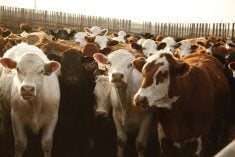MADDEN, Alta. – Every year the Eslinger family has one special meal in the field.
Fathers, mothers and children gather to reflect on the summer and look forward to harvest as another circle is completed on the farm.
Keith and Jamey Eslinger are a new kind of farmer. Born on the farm, they opted for a university education and a career elsewhere.
Keith is with Shell Canada and Jamey works for Trans-Canada Pipelines Ltd.
But the itch to get back on the land never went away.
Read Also

Growth plates are instrumental in shaping a horse’s life
Young horse training plans and workloads must match their skeletal development. Failing to plan around growth plates can create lifelong physical problems.
“Farming is in their hearts,” says Jamey’s wife Karen.
The brothers were drawn back by a deep-rooted desire to preserve the family farm, even though both had satisfying careers in a booming energy industry.
“The family farm is in jeopardy and somebody has to stand up for it to keep going,” Keith said.
“We have to figure it out.”
When an opportunity came to buy land at Madden, northeast of Calgary, they jumped at the chance.
For them the farm is the ideal place to bring up their children. As well, growing food satisfies them.
The original family farm was at Burstal, Sask., about 65 miles northeast of Medicine Hat. Four generations of Eslingers had lived there, but when their father died in 1984, the brothers were forced to farm from a distance.
The land was sold in 1989.
“Either we got out or hired people,” said Keith.
But they could not stay away for long.
They have been actively farming the Madden place for three years. Vacations, weekends and evenings are devoted to the 1,000 acre grain farm.
They want to expand their operation, but the price of land is escalating. In this part of Alberta, land is valued more as real estate than as grain producing land.
The brothers bought their first land for $800 per acre. Today that land is worth $1,600 an acre.
“The only way you can hope to farm around here is to rent,” said Keith.
The part-time farmers rely heavily on consultants.
Craig Shand of Parkland Agri-Services is like a partner on the farm. He conducts field histories for the brothers and watches the crop while they are working in the oil fields.
He also arranged for this year’s meal in the field as part of a customer appreciation program offered by many agri-companies.
Weather plays havoc
Eslinger Farms grow mostly feed barley and add some canola to the rotation. This year’s 80-bushel-per-acre yields are below average. They are blamed on five days of late-spring frost and September snow.
Harvest is perhaps the most hectic time of the year as they hurry up and wait for the swaths to dry and the skies to clear.
They run two combines to speed up operations and have trained an unlikely farmhand. Brother-in-law Curtis Marsden takes a vacation from his computer consulting business to circle the fields in a self-propelled combine.
“He’s a computer geek and he takes a month off every year to run a combine. He finds it relaxing,” Keith said.
Keeping the family together is important. They hope to instill the values of the land in their children and build a place where they will want to stay.
For Jamey and Keith, this farm is where they want to be and where they want to stay.
“You’ve got to be in it for the long haul,” Keith said.















